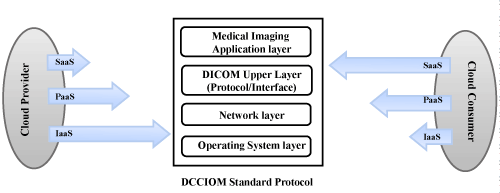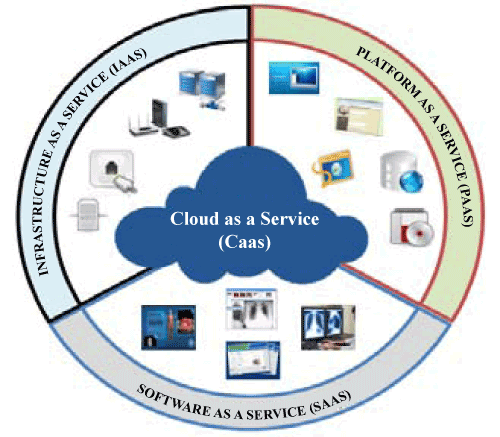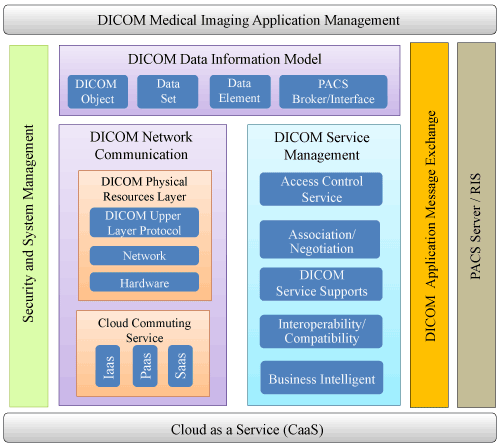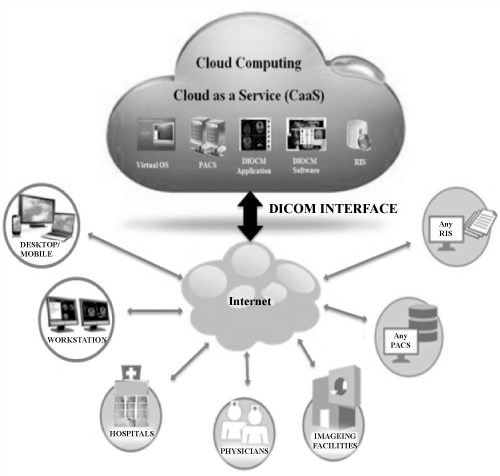|
|
| Gunjanbhai Patel* |
| Larsen & Toubro Limited, Integrated Engineering Services, Mysore, India |
| *Corresponding authors: |
Gunjanbhai Patel
Larsen & Toubro Limited
Integrated Engineering Services
Mysore, 570018 India
E-mail: gunjanbhai.patel@lnties.com |
|
| |
| Received July 3, 2012; Published August 10, 2012 |
| |
| Citation: Patel G (2012) DICOM Medical Image Management the Challenges and Solutions: Cloud as a Service (CaaS). 1: 236. doi:10.4172/scientificreports.236 |
| |
| Copyright: © 2012 Patel G. This is an open-access article distributed under the terms of the Creative Commons Attribution License, which permits unrestricted use, distribution, and reproduction in any medium, provided the original author and source are credited. |
| |
| Abstract |
| |
| In Healthcare IT-driven revolution the organizations are investing in the latest information technologies with the clear goals of reducing operating costs and improving healthcare outcomes. Cloud computing is emerging as a new trend in computational and storage resource allocation and provisioning technology. The motivation behind DICOM Cloud computing to provide service based on medical digital imaging management for authorized physicians, healthcare facilities and on demand access to patients medical images from RIS or PACS. This study of paper has discussed the DICOM Image Management to meet the challenges, the presented “Cloud as a Service (CaaS)” through conceptual architecture model for DICOM medical applications on cloud computing systems. The proposed work shows how to manage medical imaging solution on cloud based system for Digital Images application, though to provide secure service, anytime & anywhere access to medical images and instant retrieval of digital images & reports of any modality. Because of the implications for greater flexibility and availability at lower cost, cloud computing is a subject that has been receiving a good deal of attention. This paper introduces the DICOM cloud computing effective model on medical imaging solid foundation with platforms and solutions to power the cloud infrastructure for DICOM Image Management, build and run robust cloud applications, and supply end-user computing as a cloud-based service. |
| |
| Keywords |
| |
| DICOM, PACS, Medical Imaging, Cloud Computing, Radiology |
| |
| Introduction |
| |
| “Now a day, in connected world, we think instant, convenient and highly secured communication. Why should healthcare IT be an exception, when the inability to quickly obtain vital medical images and patient study information and reports can have life-threatening consequences?” asks to any PACS service providers [1]. The challenges in client-server computing, a network-friendly client version of the application was required on client computers which utilized the client system's memory and CPU for processing, even though resultant application digital images files were stored centrally on the data storage servers. |
| |
| Distributed computing is coming in the new forms as Grid and Cloud computing and all components are access via internet browser. It allows consumers and businesses to use applications without installation and access their personal files at any computer with internet access. Today in market, some of the vendors of DICOM solutions and PACS services provider follow Cloud Computing services model for medical digital images application solutions and point-of-care services to hospitals, radiology imaging centers and healthcare organization. The cloud computing technology will solve this situation for DICOM Medical Imaging Management. |
| |
| The motivation of this study to propose the novel frame work model for the communication of medical images and associated message exchange information over different networks and imaging modality. This study work to represents “Cloud Computing” to put it simply, means “Internet Computing”; hence the term “cloud computing” for computation done through the Internet for medical imaging solutions. In this paper the proposed work model defines as new phrase “Cloud as a Service” through cloud computing services model IaaS, PaaS, SaaS. This paper shows the users can access DICOM images from Cloud RIS or PACS server resources via the Internet from anywhere, for as long as they need, without worrying about any maintenance or Medical Digital Images management of actual resources of Local or connected network. Besides, DICOM images databases in cloud are very dynamic and scalable [2]. |
| |
| This paper outline, Section two describes background research, challenges of digital images management on network connected PACS/ RIS system. Section three defined proposed work a. Cloud computing services pillar according to fundament models and b. It is intended to provide cloud computing architecture model of digital images managements in cloud systems. Section four discusses for DICOM imaging solutions and application management. Conclusion session explains DICOM applications & services management for Healthcare IT in cloud computing. |
| |
| Background Research And Challenges |
| |
| Major challenges exist in managing the images and associating them to the corresponding patient and visit. Paramount to this process is a need for direct communication from one imaging device to another in order to compile data from all aspects of a patient visit, an access point where all of the information could flow, and organization information to associate with each individual patient. Without the ability to handle, store, print and transmit data, the information collected is not maximally utilized. The field of radiology is fortunate in that the specialty has a tremendous head start in the digital conversion to deal with medical records and images. |
| |
| The Department of Radiology produces several thousands of images every day. For example, CT Scanner or MRI scanner is working at the rate of 2-3 examinations per hour produces approximately average 200 images per hour, and it is not possible to classify these images in a JPEG or GIF format because it would have a risk of losses of the demographic data of the images, (name of the patient, address, type of examination, hospital, date of examination, type of acquisition, imaging modality, clinical reports etc.). |
| |
| DICOM medical imaging challenges in radiology |
| |
| • Radiology Imaging Center: Collecting DICOM data from your modalities. |
| |
| • Teleradiology Center: Networking and remote data access |
| |
| • Hospital: Getting your act together |
| |
| • Image-Processing Laboratory: Consistent and complete data of Medical Digital Images. |
| |
| • Expanding Radiology system networks, complex hardware, and the entire radiology DICOM workflow |
| |
| • Any disaster, network speed and availability |
| |
| • Adherence to appropriate Security policies and system management profiles in complex network environment for Digital DICOM images [3] |
| |
| Proposed Work |
| |
| DICOM images are integrated with different applications and so based on cloud computing services the proposed work model as explained for Healthcare IT that is hosted on their own dedicated Cloud service farms. Cloud computing has been widely recognized as the next generation’s computing infrastructure and to meet the imminent challenges of Healthcare IT shared services in Radiology center and hospital organizations. |
| |
| DICOM on cloud computing services |
| |
| Cloud computing providers offer their services according to meet the challenges and resolve the problems in Radiology Information Systems. In Figure 1 shows [4,5] the DICOM standard protocol based on various advantages by allowing cloud consumers to use infrastructure (e.g., PACS servers, networks, and Images storages), platforms (e.g., DICOM protocol upper layer, middleware services and operating systems), and software’s (e.g., DICOM application programs). Medical Image Exchange solution provides an integrated solution for automatically routing images and patients studies between PACS and Modalities without the need for VPNs or dedicated connections, it also allows referring physicians to be tightly integrated with the care team so they are able to easy view their patients images. |
| |
| |
| Cloud computing will be centralized server administration system, balances client supply, adjusts demands, monitors traffic and avoids congestion as shown in figure 1. The shared server follows DICOM Upper Layer protocol, commonly known as middleware. Middleware controls the communication of cloud network among them. As one physical server acts as multiple physical servers, it curtails the need for more physical machines. It should be noted that various cloud service models may have different requirements in related with portability and interoperability [6]. For example, IaaS requires the ability to migrate the data and run the applications on a new cloud. Thus, it is necessary to capture virtual machine images and migrate to new cloud providers which may use different virtualization technologies [7]. While for SaaS, the focus is on data interoperability, and thus it is essential to perform data extractions and backups in a standard format. |
| |
|
|
Figure 1: DICOM Standard Protocol design structure for Cloud Computing Provider and Consumer. |
|
| |
| Three fundamental service models for DICOM Imaging |
| |
| Infrastructure as a Service (IaaS): This service is promised to deliver for the new forms of Healthcare IT solutions for medical applications. DICOM Cloud computing differs from the classic clientserver model by providing applications from a PACS server that are executed and managed by a client's side, without installing any DICOM application or supported tools. |
| |
| Platform as a Service (PaaS): PaaS provides a standard development platform for building DICOM solutions, perhaps for internal healthcare organization needs or for Radiology solutions. It is a powerful solution in that it provides a standard infrastructure of DICOM services that enable rapid development of solutions with little overhead. This requires an on-demand development tool that sits on top of the cloud and provides a standard platform development as a Service. |
| |
| Software as a Service (SaaS): SaaS often provides instant deployment and scalability, helping healthcare IT businesses realize the benefits of cloud computing quickly and at reduced cost. The DICOM provided to the consumer to use the provider’s (Service Class Provider) applications running on a cloud infrastructure. |
| |
| Dicom Cloud Computing Conceptual Model |
| |
| In healthcare IT, Cloud computing is a service for enabling universal, convenient, on-demand network access to a shared pool of Medical Image Management configurable computing resources. It refers to the use of computers which access Internet locations for computing power, storage and applications, with no need for the individual access points to maintain any of the infrastructure, platform and software as services individually in Figure 3. Radiology imaging networks, PACS, RIS/HIS, Medical Imaging applications, and DICOM standard services that can be rapidly provisioned and released with minimal DICOM image management effort or DICOM service provider interaction [8]. |
| |
|
|
Figure 2: DICOM Image management on “Cloud as a Service” model. |
|
| |
|
|
Figure 3: DICOM Imaging Application Cloud Computing Architecture. |
|
| |
| Figure 3 presents the DICOM Imaging Management and cloud computing architecture, which identifies the major components, activities, and their functions over network level and cloud computing [4]. The diagram depicts a generic novel high-level architecture and is intended to facilitate the understanding of the requirements of DIMSE Message Parsing and service operations and notifications applicable to the Service Class Descriptions. |
| |
| Cloud as a Service (CaaS) |
| |
| CaaS is to be shared shorthand for a providing cloud computing instant DICOM Imaging management services, convenient and highly secured communication on top of the IaaS, PaaS and SaaS in Figure 2. Digital Imaging and Communication in Medicine which defines a method of medical images communication in RIS as well as the various equipment of digital medical images software’s and radiology modalities. Thus, the NEMA standard makes it possible for the equipment to communicate remotely through a network, media (disk or tapes), and web-based internet computing over different networks that defining a basic service would allow the top layer of the communications process (the application layer) to talk to a number of different (SCU and SCP) networks. [9] |
| |
| The Cloud services and above deployment models (Public, Private and Hybrid clouds) defined form a simple taxonomy that is not intended to prescribe or constrain any particular method of deployment, service delivery, or business operation. This model is also composed of five essential characteristics (As per the NIST Definition of Cloud Computing) - On demand self-service, Broad network access, Resource pooling, rapid elasticity, measured service [5]. Cloud computing will be centralized PACS server administration system, balances client supply, adjusts demands, monitors traffic and avoids congestion as shown in figure 2. |
| |
| DICOM cloud computing actors |
| |
| Each actor is an entity (a person or an organization and DICOM Composite object instance) that participates in a transaction or digital images storages or performs DICOM medical imaging application management tasks in cloud computing. |
| |
| Dicom data information model: The DICOM Information Model defines the structure and organization of the information related to the communication of medical images. An Information Object Definition (IOD) is an object-oriented abstract data model used to specify information about Real-World Objects. An IOD provides communicating Application Entities (patient, study, series, modality and images/reports) with a common view of the information to be exchanged. The defined DICOM message exchange information related to communication of digital medical images as per healthcare industry standard networking internet protocol TCP/IP over cloud computing services. |
| |
| The PACS broker extracts metadata from DICOM real-world object model Contents. The parser can find a Data Elements by looking it up in the DICOM object model and iterates the Data elements attribute that is encoded in the DICOM content as specified in Healthcare standards. |
| |
| Dicom services management: DICOM is processing with a servicerendering model: DICOM applications provide services to each other. Because each service involves medical imaging data exchange between SCU and SCP on cloud computing, it becomes natural to associate particular service types with the data (IODs) that they process. |
| |
| RIS/PACS server for storage: PACS server is a medical imaging technology which provides economical storage of, access to your Cloud PACS from any web connected computers, unlimited access to your stored images and reports from multiple modalities & accepts DICOM and non-DICOM objects. It connects with unlimited numbers of viewing computers, tablets, and smartphones for anywhere, anytime, any device viewing and reporting without synchronization or “orphan” study issues. The disaster recovery solutions and no additional hardware require on a cloud computing platform for RIS/ PACS storage. The cloud-hosted provider solutions also enable rapid implementation of a RIS or PACS. |
| |
| Security and security management: Security service and System management is an integral component of DICOM cloud computing services. Security, including confidentiality, the verifiability of stored information and reliability, is essential to cloud computing. DICOM image studying the security, privacy, and liability issues involving sensitive medical information in the cloud [10], various technology vendors such as IBM and Amazon have started to provide solutions for early adopters [11,12]. Guidelines for the Selection and Use of Transport Layer Security (TLS) Implementations for Cloud computing security [17] |
| |
| Discussion |
| |
| As the digital-imaging realm is embraced across the healthcare enterprise, the swift transition from terabytes to petabytes of data has put radiology on the brink of information overload. Cloud computing offers the imaging department of the future the tools to manage digital images data much more intelligently, convenient and highly secured communication. Digital Imaging and Communication in Medicine which is defined in section three and four of medical images communication in RIS as well as the various equipment of digital medical images software’s and radiology modalities. The Imaging Revolution and advance solution is the Cloud Computing Technology for DICOM Images Management will solve this situation for any Modality [3]. |
| |
| DICOM on cloud is bringing the on-demand software model to your desktop or mobile and tablets, in a single login environment see in figure 4. Furthermore, The cloud computing promises lower cost, high scalability, availability and disaster recoverability which can be a natural solution some of the problems we faced for longterm medical image archive [14]. Based on your specific needs, you can turn on new functionality over the Internet immediately. Sharing studies with a colleague is just one click away. No need of CDs, VPNs and DICOM data feeds [15]. Just one-click access to all is your imaging data and all your imaging colleagues. Import medical images and patient studies from a wide range of media, and assure the imports and correct demographic data are properly imported into PACS. |
| |
|
|
Figure 4: DICOM Imaging Application Cloud Computing Architecture. |
|
| |
| DICOM cloud computing combines the power of Zero-footprint HTML5 supported viewer and the scalability to create a universal web application for cross-enterprise clinical collaboration and universal web gateway creates scalable web services for accessing those images from any HTML5 device [16]. You can login to the DICOM cloud through internet browser and dynamically interact with patient’s DICOM medical images and structures reports [3]. There is no hardware and software needed, or maintenance fees. Buyya et al. [17] provided an extensive analysis on some of the commercially available industry leading cloud platforms, including Amazon Elastic Compute Cloud (EC2), Google App Engine, and Microsoft Azure. |
| |
| Conclusion |
| |
| Digital images are based on the current trend and high volume of medical images is leading to scalability and maintenance issues and chalanges with healthcare providers’ to enable Cross-System Functionality and Interoperability shows in proposed work for Medical Images management architecture layout on Cloud as a Services. DIOCM standard is playing role for medical imagining hardware manufacturers and application software providers. Distributed computing is coming in the new forms as Grid and Cloud computing and all components are access via internet browser. DICOM imaging application and service management has developed elastic and extremely affordable cloudbased storage to accommodate burgeoning storage capacity needs that enables nearly instant retrieval of images and reports. Sharing studies with a colleague is just one click away. Many market researchers had projected multi-billion dollar growth in the industry [14] as it promises lower cost and higher scalability to customers who need flexible and on demand access to computing resources. |
| |
| |
| References |
| |
- Rao S, Rao N, Kusuma EK (2009) CLOUD COMPUTING: AN OVERVIEW, Journal of Theoretical and Applied Information Technology, 72-76.
- Teng CC, Mitchell J, Walker C, Swan A, Davila C, et al. (2010) A Medical Image Archive Solution in the Cloud. Software Engineering and Service Sciences (ICSESS), IEEE International Conference, Beijing, China.
- Oleg SP (2012) Digital Imaging and Communications in Medicine (DICOM), A Practical Introduction and Survival Guide, Springer-Verlag Berlin Heidelberg, 247-261.
- Rebecca S, Michele MD (2011) Visualizing the Workings of Cloud Computing With Diagrams, World Clouds 2009 NASA Earth Observatory.
- National Electrical Manufacturers Association (2011) DICOM Part 8: Network Communication Support for Message Exchange, PS 3.8, 10-25.
- Steven CH, Fred WP, Bidgood WD, DICOM: An Introduction to the Standard.
- Cloud Security Alliance (2009) Security Guidance for Critical Areas of Focus in Cloud Computing.
- Oracle Multimedia DICOM Concepts (2009) Oracle Multimedia DICOM Developer's Guide11g Release 1,Part no: B2841.
- National Electrical Manufacturers Association (2011) Digital Imaging and Communications in Medicine (DICOM)-Part 1, Introduction and Overview, PS 3.1-2011, 11-20
- Jaeger PT, Lin T, and Grimes JM (2008) Cloud computing and information policy: Computing in a policy cloud?. Journal of Information Technology & Politics 5: 269-283.
- https://insiteone.com/news-pressreleases.php?newsID=63
- https://aws.amazon.com/solutions/case-studies/harvard/
- Steve H (2009) How cloud computing will change business, Business Week.
- https://www.dicomgrid.com/ solutions/ archive.php
- James DW, Susan WW, Fellander LT, Helene MH (2011) Medicine Meets Virtual Reality 18, NextMed IOS Press, 671-673.
- Buyya R, Yeo CS, Venugopal S, Broberg J, and Brandic I (2009) Cloud computing and emerging IT plaforms: vision, hype, and reality for delivering computing as the 5th utility”, Future Generation Computing Systems 25: 599-616.
- Michael CC, Charles EIII, Matthew JF, Rosenthal R, (2005) Guidelines for the Selection and Use of Transport Layer Security (TLS) Implementations. NIST Computer Security Division.
|
| |
| |




